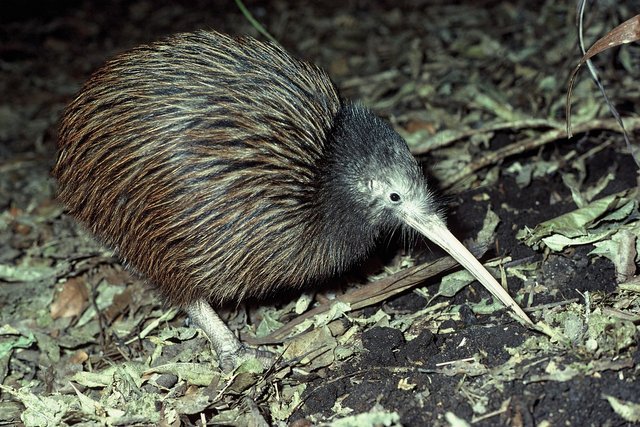The Kiwi: New Zealand’s Iconic National Bird and Its Conservation
New Zealand has five species of kiwi, a native bird unique to the country, that has become endangered through predation and habitat change.
The kiwi is the national bird of New Zealand and a symbol recognised globally that represents the country and its people. However, this iconic, flightless bird has suffered from the human impact on its environment and the predators they introduced.
Kiwi Classification and Biology
A member of the ratite family of birds, kiwi are related to ostriches in Africa, emus and cassowaries in Australia, and the now-extinct moas once widespread in New Zealand.
Kiwi classification is complex. Three species of kiwi exist, one with three recognised subspecies. However, studies have shown that the brown kiwi may be three distinct species and other subspecies may also be recognised.
The great spotted kiwi (Apteryx haastii) is the largest species, growing up to 45cm high. It has streaky grey and brown plumage.

Apteryx haastii credit
The little spotted kiwi (Apteryx oweni) is the smallest species, growing up to around 30cm high. Its plumage is similar to its larger cousin. Both species have soft, loose, hair-like feathers.

Apteryx oweni credit
The third species is the brown kiwi. The North Island brown kiwi (Apteryx mantelli) is about 40cm high with red-brown plumage and stiff, spiky feathers. The Okarito brown kiwi or rowi (Apteryx rowi) is slightly smaller and has a greyer plumage. The southern tokoeka (Apteryx australis) has a slightly lighter coloured plumage than the other brown kiwis and is about the same size as the great spotted kiwi. It exists in three geographically isolated groups on Stewart Island, and in Fiordland and the Haast Range in the South Island. Some scientists consider these separate species or subspecies.

Apteryx mantelli credit
In all species, the female is distinctly larger than the male. The Latin name, Apteryx, means ‘no wings’ because kiwi are flightless. Kiwi therefore live on the ground and nest in natural holes or those they dig in banks, tree roots, under rocks or on open ground.
The spotted kiwi lay only one egg per season, with the brown kiwi laying two or sometimes three. The eggs are white or greenish and huge compared to most bird species, about quarter the weight of the adult female. In brown kiwi, the male incubates the eggs. Kiwi are territorial and usually live in monogamous pairs. They can live over 30 years.
All kiwi species are nocturnal. Unlike other birds, they have nostrils at the end of their long, slender beaks which they use to smell out insects, worms, seeds and fruit in the soil. Tactile hairs at the base of their beak help them feel for movement. They are clearly audible at night, snuffling through the undergrowth. They have prominent ear holes and use their powerful legs and feet to forage for food and dig nest holes.
Kiwi Threats and Conservation
Kiwi populations have declined dramatically since humans arrived in New Zealand. Maori prized kiwi feathers to decorate ceremonial cloaks and ate kiwi. White settlers brought predatory species such as stoats, ferrets, dogs and cats that attacked the vulnerable ground-dwelling birds. Kiwi are often killed on roads.
The Department of Conservation estimates the total kiwi population is declining by 5.8 per cent a year, which is alarming. Around 50,000 kiwi remain, the brown species being the most common and the little spotted the rarest. It survives only on offshore islands, such as Kapiti Island and Tiritiri Matangi. The only mainland population lives at the predator-free Karori Sanctuary in Wellington, which has around 100 birds.
Many kiwi protection programmes exist around New Zealand to safeguard nests, raise and release chicks, research their ecological needs and genetics, and help land owners protect birds on private estates.
The kiwi is a critical part of the New Zealand national identity and is considered a taonga, or treasure. All New Zealanders and visitors to the country have a role in safeguarding its future through awareness, funding and active participation.
Congratulations! This post has been upvoted from the communal account, @minnowsupport, by vermute from the Minnow Support Project. It's a witness project run by aggroed, ausbitbank, teamsteem, theprophet0, and someguy123. The goal is to help Steemit grow by supporting Minnows and creating a social network. Please find us in the Peace, Abundance, and Liberty Network (PALnet) Discord Channel. It's a completely public and open space to all members of the Steemit community who voluntarily choose to be there.
If you like what we're doing please upvote this comment so we can continue to build the community account that's supporting all members.
This post has received a 0.39 % upvote from @drotto thanks to: @banjo.
Great content!! Congratulations for this and other bird related posts!